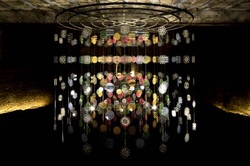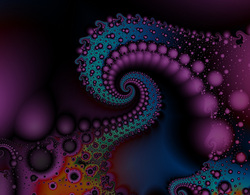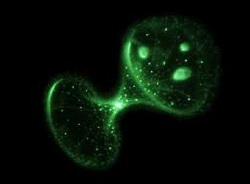 Yesterday I took a train to London to visit the Superposition Exhibition at the Canal Museum. The experience was interesting, eventful and enlightening. This project is a blend of art and science which is aimed at exposing the underbelly of physics to the world at large, in order to negate some of the fear which seems to follow this particular science around. "Say to someone, 'that's physics', and they run a mile," said one of the contributors. The project was engineered by the Institute of Physics - I learned during the discussion session later that CERN even has artists on-site full-time to engage with scientists. So the blend of mind-sets is clearly considered to be of some worth. The online flyer asks and answers an intriguing question: Why is this show called Superposition?' Superposition' is a physics concept describing two different phenomena:
 The question begged by the image here (click on it for a link to its originator) is, "Fractal Art or Quantum Physics?", from an article written in 2009. Fusion of art and quantum activity is therefore nothing new, although it could be said to be an emerging trend which has got a lot of people and organisations interested in the implications of such collaborations. Myself included... I asked a couple of questions at the audience-participation session which others in the audience also asked in different ways. Where is this collaboration going? Does it signify the dawn of a new destiny for physics, where artisan imagery is dovetailed with equations? Are the old constraints and constants heading for the door, in the wake of opportunities to expand the world view? There was an awkward silence. It seems that with all the best intentions of unexpected consequences, the marriage of art and science has been carefully arranged but true love is a little harder to husband. Each time the question of deeper collaboration was posed directly, the answer veered off to concentrate on the artwork itself or the physics itself, rather than a future for the two together. Truly, Ben Still and Lyndall Phelps, scientist and sculptor who'd put this show on the road, seemed comfortable about their joint venture and committed to furthering it with future projects. But there was space for genuine excitement about sowing a seed which would lead to lusher harvest than dust-dry formulas from the academic table and whimsical imagery from the artist's studio. A space which, after a full month of these discussion sessions, Ben and Lyndall still struggled to fill.  This is not a prescience of doom and gloom, but a realistic call for questions to generate the energy physics needs if it truly wants to engage with the public and capitalise on opportunities the quantum world is throwing in its direction. Quantum is a sexy word. Product manufacturers and film-makers who want to get ahead are jumping all over it. Quantum has sexy implications - we can multi-task on a whole new level if we really get to grips with superposition. Physics has a choice - to stick on a hand of familiar formulas and pre-moulded mathematics, or cash in some of its chips in exchange for a path of uncertainty and oscillation. Quite clearly the neutrino would lean towards the latter, probably agreeing with the artist in so doing. At this moment in current spacetime the two camps in the relationship seem equally uncertain of each other.
0 Comments
Leave a Reply. |
AuthorKathy is the author of Quantumology. She met up with quantum mechanics in 1997, pledging allegiance to its sources thereafter. These are her personal thoughts and testimonies. Archives
April 2023
|
 RSS Feed
RSS Feed